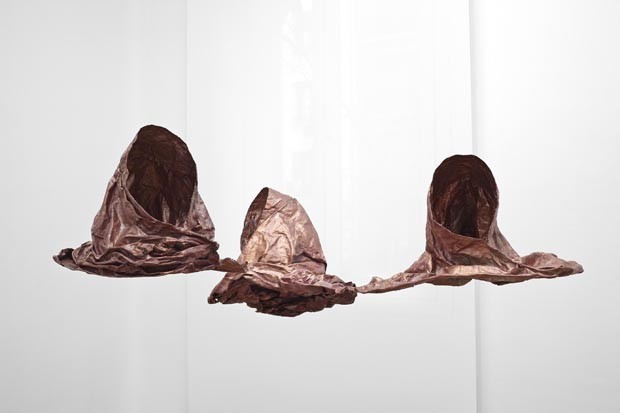Lucía Vallejo
06 Mar - 30 May 2013
LUCÍA VALLEJO
Plegando el vacío
6 March – 30 May 2013
The junction between the use of pictorial techniques and the obsession to fill the vacuum may be the origin of the sculpture of Lucia Vallejo (Bilbao, 1975). The way in which the canvases are transformed into sculpture in the space that the artist has given them, brings meaning to the work and defines the personal position of the artist within today ́s contemporary art scene.
Plegando el vacío is the third solo show of Vallejo. The sculptures shown in this occasion are formulated through the most characteristic coordinate perhaps of the Spanish sculptor: the attraction of transforming what is two-dimensional in a three-dimensional sculpture in a constant struggle against gravity.
In Vallejo ́s work the process of creation becomes as important as the end result of the work, like the prerrafaelitas she is in a continuous search of the origins, using pure materials, giving to her work a nostalgic nature. Drawing inspiration from ancient times, specifically in the baroque, she manages to give volume to the vacuum. Folds and pleats make up a more abstract dimensionality that makes the sculpture rest naturally on the canvas in a haphazard and self reflective mode at the same time.
It is no mere coincidence her inspiration in the baroque period, the vacuum and the concern by the passing of time were very recurrent themes in this period, that not only inspire the artist aesthetically but she also identifies with its symbolism. Vallejo denounces the relativity of knowledge and of the human race to the passing of time and death that are constant themes in her work.
"They are, without doubt, her more baroque works, -said Oscar Alonso Molina - that can be interpreted in the line of some internationally famous works by Lee Bul, and even in a more distant way to the works by Petah Coyne or Matthew Ritchie. For a full enjoyment there is also to be taken into consideration the good scenario created by sheds and enhancing illumination, projecting tenebrists shadows that force the viewer to surround them to conquer them fully. In its turn that invites our own, while melting its shadow with the exhibition space, we are invited to enjoy the baroque development in its peak: when the disciplines tend to spill among each other, further eroding its borders, thus giving rise to a last merge of the world with the artificial scenario created: we live and unfold ourselves in the middle of a rhetoric where the artistic invades the area of what is real, it is proceeding with its blistered body toward us, and ends by enveloping us.”
Plegando el vacío
6 March – 30 May 2013
The junction between the use of pictorial techniques and the obsession to fill the vacuum may be the origin of the sculpture of Lucia Vallejo (Bilbao, 1975). The way in which the canvases are transformed into sculpture in the space that the artist has given them, brings meaning to the work and defines the personal position of the artist within today ́s contemporary art scene.
Plegando el vacío is the third solo show of Vallejo. The sculptures shown in this occasion are formulated through the most characteristic coordinate perhaps of the Spanish sculptor: the attraction of transforming what is two-dimensional in a three-dimensional sculpture in a constant struggle against gravity.
In Vallejo ́s work the process of creation becomes as important as the end result of the work, like the prerrafaelitas she is in a continuous search of the origins, using pure materials, giving to her work a nostalgic nature. Drawing inspiration from ancient times, specifically in the baroque, she manages to give volume to the vacuum. Folds and pleats make up a more abstract dimensionality that makes the sculpture rest naturally on the canvas in a haphazard and self reflective mode at the same time.
It is no mere coincidence her inspiration in the baroque period, the vacuum and the concern by the passing of time were very recurrent themes in this period, that not only inspire the artist aesthetically but she also identifies with its symbolism. Vallejo denounces the relativity of knowledge and of the human race to the passing of time and death that are constant themes in her work.
"They are, without doubt, her more baroque works, -said Oscar Alonso Molina - that can be interpreted in the line of some internationally famous works by Lee Bul, and even in a more distant way to the works by Petah Coyne or Matthew Ritchie. For a full enjoyment there is also to be taken into consideration the good scenario created by sheds and enhancing illumination, projecting tenebrists shadows that force the viewer to surround them to conquer them fully. In its turn that invites our own, while melting its shadow with the exhibition space, we are invited to enjoy the baroque development in its peak: when the disciplines tend to spill among each other, further eroding its borders, thus giving rise to a last merge of the world with the artificial scenario created: we live and unfold ourselves in the middle of a rhetoric where the artistic invades the area of what is real, it is proceeding with its blistered body toward us, and ends by enveloping us.”

